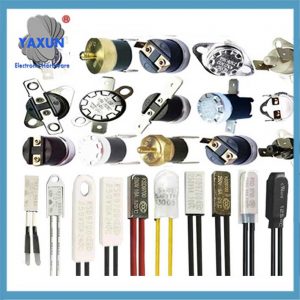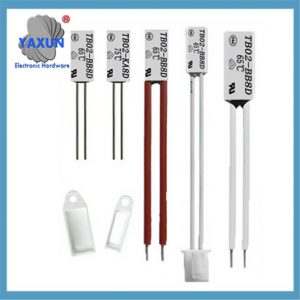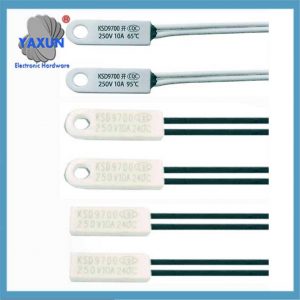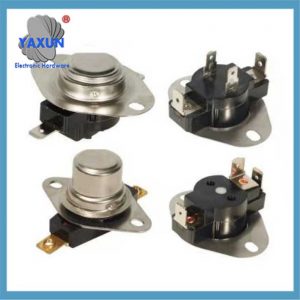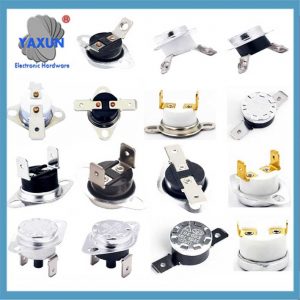The following is the core difference and selection guide of the bimetallic KSD301, KSD9700 normally closed (NC) and normally open (NO) temperature switches, and a comprehensive comparison of technical specifications and application scenarios:
I. Working principle and state definition
| Characteristics | Normally closed (NC) | Normally open (NO) |
| Initial state | Contacts closed at normal temperature (circuit connected) | Contacts disconnected at normal temperature (circuit disconnected) |
| Trigger action | Temperature ≥ set value → contacts disconnected (circuit disconnected) | Temperature ≥ set value → contacts closed (circuit connected) |
| Reset mechanism | Temperature drops to reset value → contacts automatically closed | Temperature drops to reset value → contacts automatically disconnected |
| Symbols | NC (Normally Closed) | NO (Normally Open) |
Core application logic:
NC type: “high temperature power off” (such as preventing the motor from overheating and burning);
NO type: “high temperature power on” (such as over-temperature starting the cooling fan).
II. Typical application scenarios
KSD301 Temperature Switch Parameters
| Type | Applicable equipment | Protection purpose |
| NC type | – Motor overheat protection (washing machine, air conditioner compressor) – Electric water heater anti-dry burning – Transformer overload protection |
When the temperature exceeds the standard, the power supply is forced to be cut off to avoid equipment damage |
| NO type | – Cooling fan control (computer CPU, cabinet) – Heater overtemperature alarm – Greenhouse heating system |
Activate auxiliary equipment (such as fans/alarms) when the temperature exceeds the standard |
III. Key considerations for selection
Safety priority
NC type must be selected for forced power off scenarios (such as fire prevention, electric shock prevention) to avoid accidents caused by continuous power supply at high temperatures.
Circuit design matching
NC type needs to be connected in series in the main circuit live wire, and NO type is usually connected in parallel to control auxiliary equipment.
Identification
“B” or “NC” marked on the shell indicates normally closed type, “K” or “NO” indicates normally open type (such as KSD301-85B indicates normally closed type at 85℃).
Test verification
Use a multimeter to detect: NC type is connected at normal temperature, and NO type is disconnected at normal temperature.
IV. Avoiding operational errors
mermaid Copy Code
graph TB
A[Equipment requirements] –> B{Does it need to be powered off at high temperature? }
B –>|Yes| C[Select NC type]
B –>|No| D{Does it need to be started at high temperature? }
D –>|Yes| E[Select NO type]
D –>|No| F[Re-evaluate the design]
▶️ Summary: NC type is the “emergency brake” for safety protection, and NO type is the “temperature trigger” for intelligent control. The action logics of the two are complementary. The selection must strictly match the circuit function requirements (comprehensive).
 English
English Afrikaans
Afrikaans العربية
العربية বাংলা
বাংলা bosanski jezik
bosanski jezik Български
Български Català
Català 粤语
粤语 中文(简体)
中文(简体) 中文(漢字)
中文(漢字) Hrvatski
Hrvatski Čeština
Čeština Nederlands
Nederlands Eesti keel
Eesti keel Suomi
Suomi Français
Français Deutsch
Deutsch Ελληνικά
Ελληνικά हिन्दी; हिंदी
हिन्दी; हिंदी Magyar
Magyar Bahasa Indonesia
Bahasa Indonesia Italiano
Italiano 日本語
日本語 한국어
한국어 Latviešu valoda
Latviešu valoda Lietuvių kalba
Lietuvių kalba македонски јазик
македонски јазик Bahasa Melayu
Bahasa Melayu Norsk
Norsk پارسی
پارسی Polski
Polski Português
Português Română
Română Русский
Русский Cрпски језик
Cрпски језик Slovenčina
Slovenčina Slovenščina
Slovenščina Español
Español Svenska
Svenska ภาษาไทย
ภาษาไทย Türkçe
Türkçe Українська
Українська اردو
اردو Tiếng Việt
Tiếng Việt

